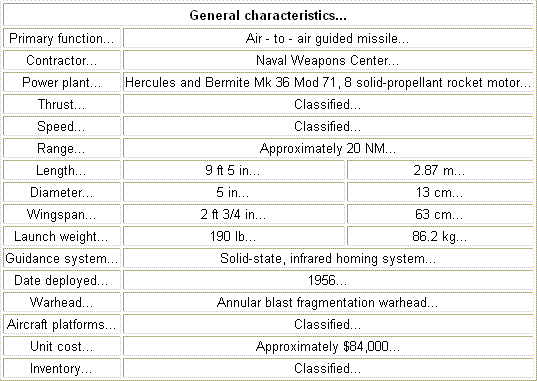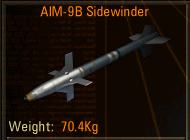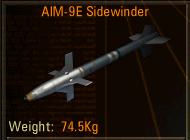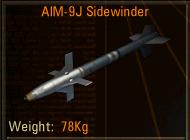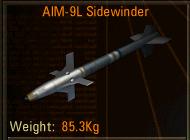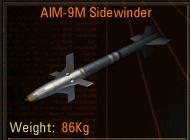
Info about the "Air to Air" Missiles...
AIM - 9 Sidewinder...
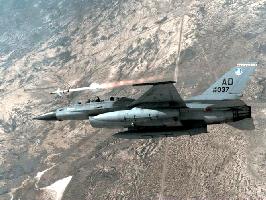
Background...
The AIM-9 Sidewinder is a supersonic, heat-seeking, air-to-air missile carried by fighter aircraft. It has a high-explosive
warhead and an active infrared guidance system. The Sidewinder was developed by the US Navy for fleet air defense and was
adapted by the U.S. Air Force for fighter aircraft use. Early versions of the missile were extensively used in the
Southeast Asian conflict. In September 1958 Chinese Nationalist F-86s fired the first Sidewinder air-to-air missiles
to down 11 communist Chinese MiG-17s over the Formosa Straits. Until that time, aircraft defensive means where primarily
limited to pilots and tail gunners firing small caliber ammunition in dog-fight situations. The AIM-9 has a cylindrical
body with a roll-stabilizing rear wing/rolleron assembly. Also, it has detachable, double-delta control surfaces behind
the nose that improve the missile's maneuverability. Both rollerons and control surfaces are in a cross-like arrangement.
The missile's main components are an infrared homing guidance section, an active optical target detector, a high-explosive
warhead, and a rocket motor. The infrared guidance head enables the missile to home on target aircraft engine exhaust. An
infrared unit costs less than other types of guidance systems, and can be used in day/night and electronic countermeasures
conditions. The infrared seeker also permits the pilot to launch the missile, then leave the area or take evasive action
while the missile guides itself to the target.
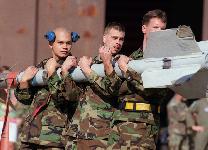
Variants...
The development process has produced increased capabilities with each missile modification. The AIM-9A, prototype of the
Sidewinder, was first fired successfully in September 1953. The initial production version, designated AIM-9B, entered the
Air Force inventory in 1956 and was effective only at close range. It could not engage targets close to the ground, nor did
it have nighttime or head-on attack capability. These shortcomings were eliminated on subsequent versions. The AIM-9G
provided the capability to lock on and launch against a target offset from the axis of the launch aircraft. The AIM-9H
configuration replace vacuum tubes with solid-state modules and a thermal battery replaced the turbo-alternator. The
AIM-9H was configured with a continuous-rod bundle warhead. The AIM-9J, a conversion of the AIM-B and E models, has
maneuvering capability for dogfighting, and greater speed and range, giving it greater enhanced aerial combat capability.
Deliveries began in 1977 to equip the F-15 and other Sidewinder-compatible aircraft. The AIM-9L added a more powerful
solid-propellant rocket motor as well as tracking maneuvering ability. Improvements in heat sensor and control systems
have provided the AIM-9L missile with an all-aspect attack capability and improved guidance characteristics. The L model
was the first Sidewinder with the ability to attack from all angles, including head-on. An improved active optical fuze
increased the missile's lethality and resistance to electronic countermeasures. A conical scan seeker increased seeker
sensitivity and improved tracking stability. The AIM-9L is configured with an annular blast fragmentation warhead.
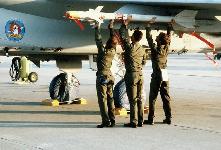
Production and delivery of the AIM-9L began in 1976. The AIM-9M missile utilizes a guidance control section with
counter-countermeasures and improved maintainability and producibility. The AIM-9M is configured with an annular
blast fragmentation warhead. The AIM-9P, an improved version of the J model, has greater engagement boundaries,
enabling it to be launched farther from the target. The more maneuverable P model also incorporated improved solid-state
electronics that increased reliability and maintainability. Deliveries began in 1978. The AIM-9P-1 has an active optical
target detector instead of the infrared influence fuze; the AIM-9P-2 added a reduced-smoke motor. The most recently
developed version, the AIM-9P-3, combined both the active optical target detector and the reduced-smoke motor. It also
has added mechanical strengthening to the warhead as well as the guidance and control section. The improved warhead uses
new explosive material that is less sensitive to high temperature and has a longer shelf life. The AIM-9M, currently the
only operational variant, has the all-aspect capability of the L model, but provides all-around higher performance. The M
model has improved defense against infrared countermeasures, enhanced background discrimination capability, and a
reduced-smoke rocket motor. These modifications increase ability to locate and lock-on a target and decrease the
missile's chances for detection. Deliveries of the M model began in 1983. The AIM-9M-9 has expanded infrared counter
measures detection circuitry. The AIM-9X Sidewinder Air-to-Air missile program will develop a short range heat seeking
weapon to be employed in both offensive and defensive counter-air operations. Offensively, the weapon will assure that US
and combined air forces have the ability project the necessary power to insure dominant maneuver. In the defensive
counter-air role, the missile system will provide a key capability for force protection. The multi-service Air Intercept
Missile (AIM-9X Sidewinder) development will field a high off-boresight capable short range heat seeking missile to be
employed on US Air Force and Navy/Marine Corps fighters.
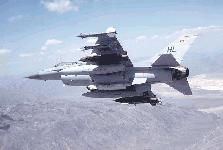
The missile will be used both for offensive and defensive counter-air operations as a short range, launch and leave air
combat missile that uses infra red guidance. The AIM-9X will complement longer range radar guided missiles such as the
Advanced Medium Range Air-to-Air Missile (AMRAAM). The new missile is required to reestablish the parity of US aircraft
in short range air combat, vis-a-vis improved foreign export aircraft and missiles. Specific deficiencies exist in the
current AIM-9M in high off-boresight angle capability, infra-red counter-countermeasures robustness, kinematic performance,
and missile maneuverability. The MiG-29 with its AA-10/AA-11 missiles are the major threat to US forces. Additionally,
there are a number of other missiles on the world market that outperform the current US inventory AIM-9M weapon system in
the critical operational employment areas. The AIM-9X will expand the capabilities of the current AIM-9M by developing a
new seeker imaging infra-red focal plane array, a high performance airframe, and a new signal processor for the
seeker/sensor. The current acquisition strategy seeks to retain the warhead, fuze, and rocket motor of the current
design in order to capitalize on the large existing inventory of AIM-9 weapons. The F-15C/D and the F/A-18C/D will be
the initial platforms for integration and T&E. The early operational assessment of the Hughes and Raytheon DEMVAL results
was that both the Hughes and Raytheon missiles showed potential for meeting both the mission effectiveness and suitability
requirements of the AIM-9X operational requirements document. Specifically, all critical operational issues were rated
green (potentially effective/suitable) except counter-countermeasures capability, lethality, built in test functionality,
and reprogrammability.
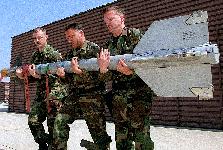
Counter-countermeasures capability of both missiles was initially below the operationally required threshold values,
however the Hughes missile showed a rapid improvement through the course of the evaluation. The missiles demonstrated
acceptable performance levels in the air-to-air phase. The other assessment areas not resolved as green had insufficient
data for conclusive evaluation. However, again, the risk of either DEMVAL missile not meeting the threshold requirement
was rated as low. The results of the operational assessment were integral to the Service source selection decision to
award the engineering, manufacturing, development contract to Hughes Missile Systems Corporation. The early operational
assessment of the British ASRAAM foreign comparative test (FCT) focused on the risk areas of the ASRAAM: focal plane
array effectiveness, seeker signal processing, warhead effectiveness, rocket motor testing, and kinematic/guidance
ability to support the lethality requirements of the AIM-9X. The resulting assessment was that the ASRAAM (as is)
cannot meet the AIM-9X operational requirements in high off-boresight angle performance, infrared counter-countermeasures
robustness, lethality, and interoperability.
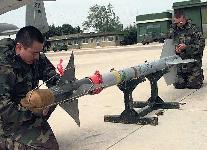
The AIM-9X is a supersonic, air-to-air, guided missile which employs a passive IR target acquisition system, proportional
navigational guidance, a closed-loop position servo Control Actuation Section (CAS), and an AOTD. The AIM-9X is launched
from an aircraft after target detection to home in on IR emissions and to intercept and destroy enemy aircraft. The missile
interfaces with the aircraft through the missile launcher using a forward umbilical cable, a mid-body umbilical connector
and three missile hangars. The AIM-9X has three basic phases of operation: captive flight, launch, and free flight. The
AIM-9X utilizes the existing AIM-9M AOTD, warhead, and rocket motor, but incorporates a new Guidance Section (GS), new
hangars, a new mid-body connector, new harness and harness cover, new titanium wings and fins, and a new CAS. The missile
is propelled by the AIM-9M solid-propellant rocket motor, but uses a new Arm and Fire Device (AFD) handle design. Also, the
AIM-9M rocket motor is modified to mount the CAS on its aft end. Aerodynamic lift and stability for the missile are
provided by four forward-mounted, fixed titanium wings.
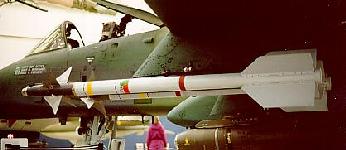
Airframe maneuvering is accomplished by four titanium control fins mounted in line with the fixed wings and activated by
the CAS, which includes a thrust vector control system that uses four jet vanes to direct the flow of the rocket motor
exhaust. The AIM-9X is configured with the AIM-9M Annular Blast Fragmentation (ABF) warhead, which incorporates a new
Electronic Safe and Arm Device (ESAD) to arm the warhead after launch. The AIM-9M AOTD is used to detect the presence
of a target at distances out to the maximum effective range of the missile warhead and command detonation.
Guidance Section...
The GS provides the missile tracking, guidance, and control signals. It consists of three major subassemblies: (1) a
mid-wave IR Focal Plane Array (FPA) seeker assembly for detecting the target, (2) an electronics unit that converts the
detected target information to tracking and guidance command signals, and (3) a center section containing the cryoengine,
contact fuze device, two thermal batteries, and required harnesses and connectors. The coolant supply for the GS is
provided by the twin-opposed-piston, linear drive, stirling cryoengine.

Forward Hangar/Mid-body Umbilical Connector and Buffer Connector...
The hangers on the AIM-9M rocket motor are replaced by slightly "taller" hangers for AIM-9X. These taller hangers provide
additional separation between the missile and the launcher. This separation is needed to provide adequate clearance for
the AIM-9X on all the launcher configurations. The middle and aft hanger mounting is unchanged from the AIM-9M
configuration. The forward hanger is replaced by an integrated forward hanger/mid-body umbilical assembly. The mid-body
umbilical connector adds a mid-body interface with the LAU-127 launcher. This connection provides the missile MIL-STD-1553
digital communications with the launching aircraft, and requires a buffer connector similar to the Advanced Medium-Range
Air-to-Air Missile (AMRAAM) buffer connector. The forward hanger/mid-body umbilical assembly is an integrated assembly
that consists of the hanger, the mid-body umbilical connector, the umbilical cabling, and the rocket motor AFD wiring to
the hanger striker points. The rocket motor AFD wiring is unchanged from that used in the AIM-9M and will interface with
the striker points as in the AIM-9M configuration.
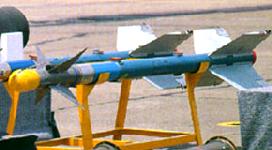
Harness and Harness Cover...
Unlike the AIM-9M, an electronic harness has been added to the AIM-9X to provide the communications interface between the
electronics unit in the GS and the other missile components. Due to the lack of space internally, the harness had to be
mounted externally on the underside of the missile surface. The harness cover spans most of the length of the missile and
provides an aerodynamic surface and protective cover for the electronic harness and the CAS electronic circuit board. The
AIM-9X will utilize mid-wave IR FPA seeker technology in lieu of the single-element IR seeker used in the AIM-9M. The
AIM-9X will be a digital missile with Built-In-Test (BIT) and re-programming capability that is not present in the the
analog AIM-9M. A buffer connector must be used on the mid-body umbilical connector when the AIM-9X is loaded on the
LAU-127 launcher. The AIM-9X will use an internal cryogenic engine, called a cryoengine, for IR element cooling. The
cryoengine does not require externally-supplied coolant, e.g., nitrogen, and thus does not use the nitrogen receiver
assemblies contained in the LAU-7 and LAU-127 launchers, which provide IR element coolant for the AIM-9M. The AIM-9X
will use titanium wings and fins. Also, the AIM-9X will use a CAS to direct movement of the aft fins and four internal
jet vanes. The jet vanes direct the flow of the rocket motor exhaust to generate thrust vector control.
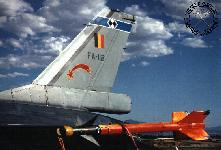
Fleet introduction of the AIM-9X missile is planned to begin in FY02 via aircraft carrier load outs. Low-Rate Initial
Production (LRIP) All-Up-Round (AUR) missile deliveries begin in FY01 and continue through FY04, when Full-Rate Production
deliveries begin. The AIM-9X seeks and homes in on IR energy emitted by the target. When an IR-emitting source enters the
seeker field of view, an audio signal is generated by the electronics unit. The pilot hears the signal through the headset,
indicating that the AIM-9X has acquired a potential target. One method of cueing the AIM-9X to the targetís IR energy
source is referred to as boresight, whereby the missile is physically pointed toward the target via the pilot maneuvering
the aircraft. The IR energy gathered by the missile seeker is converted to electronic signals that enable the missile to
acquire and track the target up to its seeker gimbal limits. A second method of cueing the AIM-9X to the targetís IR energy
is the Sidewinder Expanded Acquisition Mode (SEAM). SEAM slaves the AIM-9X seeker to the aircraft radar. The aircraft
avionics system can slave the missile seeker up to a given number of degrees from the missile/aircraft boresight axis.
The missile seeker is slaved until an audible signal indicates seeker target acquisition. Upon target acquisition, a seeker
interlock in the missile is released (uncaged) and the missile seeker begins tracking the target.
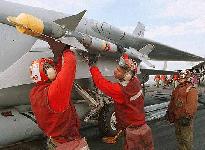
The AIM-9X seeker will then continue to track the target. A third method for cueing the AIM-9X to the targetís IR energy
is through use of the JHMCS. This method allows the pilot to cue the AIM-9X seeker to high off-boresight targets via helmet
movement. The pilot can launch the AIM-9X anytime after receipt of the appropriate audible signal. The AIM-9X is required
to be compatible, at full capability, with the F/A-18C/ D/E/F, F-15C/D/E, F-16C/D, and F-22 aircraft, and be capable of
being used in a reduced capacity on other aircraft with MIL-STD-1760 signal set capability (F-14B Upgrade, F-14D, AV-8B,
and AH-1W). The AIM-9X is also backward compatible to aircraft/launchers only capable of AIM-9M analog communication. For
analog interfaces, the AIM-9X operates, and is identified, as an AIM-9M. This backward compatibility includes the analog
seeker slave mode. The AIM-9X will be integrated with the Joint Helmet Mounted Cueing System (JHMCS), a helmet-mounted
display with capability to cue and verify cueing of high off-boresight sensors and weapons. This missile-helmet marriage
will provide the aircrew with first-look, first-shot capability in the air-to-air, within visual range, combat arena.
Increased off-boresight acquisition angle and improved situational awareness will be achieved through the integrated
combination of the AIM-9X missile, the JHMCS and the aircraft. For the USN and United States Marine Corps (USMC), two
guided missile launchers are available to carry and launch the AIM-9X on the F/A-18 aircraft. The LAU-7 guided missile
launcher can be used on all applicable Sidewinder weapons stations, however, it requires modification of the current
power supply and the addition of digital and addressing lines to the forward umbilical to carry and launch the AIM-9X.
With these modifications, it will be designated the LAU-7D/A. The LAU-127 guided missile launcher can be used on the
F/A-18 aircraft wing stations only. F/A-18 aircraft wing stations require a LAU-115 guided missile launcher in order
to attach the LAU-127.
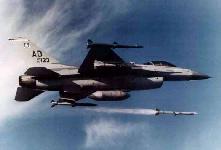
We have 5 variants at the game...
